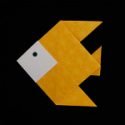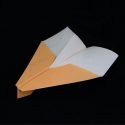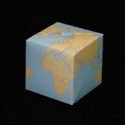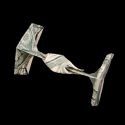Textual Information
Florence Temko Origami Collection
- read about Neal Elias by David Lister
- go to Tribute to Neal Elias web page
- read about Fred Rohm by David Lister
NEAL ELIAS
Taken from “The Origins of the Origami Center: The Art of Origami” by David Lister
Neal Elias is a modest, retiring person who has tended to avoid meeting other folders. His contact has mainly been in his extensive correspondence. Yet by any standards he is one of the giants of the history of paper-folding. His reserve has prevented us from knowing much about his personal history, but he said that he came to paper-folding through two books: Murray and Rigney’s “Fun with Paper-Folding” and Houdini’s “Paper Magic”. It may come as no surprise that Neal Elias was a conjurer before he was a paper-folder, and a creative one at that. He became a skilled card manipulator and wrote a book on card magic.
Neal Elias has not disclosed just when he took up paper-folding but the early 1950’s seem likely. He had other interests, including some aspects of folklore, and it was in connection with this entirely separate subject that he wrote to Gershon Legman, just after he had moved to live in France in 1953. Somehow the subject of paper-folding cropped up and Legman sent a number of folds by himself and by Unamuno and Yoshizawa. Once more we catch a glimpse of the way Gershon Legman encouraged and influenced the development of paper-folding despite his isolation far away in France. Immediately Neal Elias was inspired by the new folding and his mild interest in the pastime became one of intense dedication.
Neal’s first reaction was to copy the models sent to him by Gershon Legman. By a fortunate decision he also began preparing diagrams of the folds as an aide memoire for himself. The first models he copied were a dromedary and a parrot by Legman, followed by Solorzano’s goat. Soon he was beginning to devise his own models, one of his first being a toucan. A little later he was introduced to other folders. John Nordquist of California helped him to acquire some books in Japanese. He was put in touch with the Origami Center and Lillian introduced him in turn to Sam Randlett. The year would probably be 1959. We see how the net-work of folders which was building up as a result of the formation of the Origami Center was beginning to develop. Neal Elias has said that it was after his correspondence with Sam Randlett started that he actively began to create his own models. Retiring he might be, but he was an active letter-writer and was soon corresponding with other creative folders including Robert Harbin, Ligia Montoya and her fellow Argentinian, Adolfo Cerceda, and also Fred Rohm. They all played a sort of Origami tennis, where one would send a fold to another who would study it, improve it, modify it or transform it into something quite different and then send it back.
Neal Elias’s meticulous notebooks record not only his models but also their dates, so that it is possible to trace the progress of his creativity. The outstanding characteristic of his folding was his abundant imagination, both in his techniques of folding and in the subjects of his folding. He came to use foil for many, if not most of his models. Foil kept its creases better than paper and this was an important advantage for the complex folding which Neal developed.
Neal was very eclectic with his bases. His first models, as was not unusual at the time, tended to be folded from the bird base, but he manipulated it in new and unexpected ways. He also used advanced bases including those devised by George Rhoads and Adolfo Cerceda and he did not confine himself to folding from a square. He took inspiration from Adolfo Cerceda’s “Moor on Horseback” which was one of the first two-figure models folded from a single uncut piece of paper (in this case a double square) and went on to create many composite models of his own. As time passed Neal Elias’s folding became more complex and he began to employ a new technique which will always be associated with him and which has come to be known as “box-pleating”. (“Box-pleating” must be distinguished clearly from another style of folding called “box-folding” of which the pioneer was Dr. Emmanuel Mooser of Switzerland). Whether or not Neal Elias was the first folder to combine pleated folding (which is found in other contexts, like lampshades, bellows and trouble-wit) with the techniques of Origami seems unlikely, but he certainly used it extensively and developed it with amazing creativity, producing models which scarcely betray their origins in the regular pleating of the paper. It is an impossible task to select a few representative examples of Neal Elias’s folds, but “Rodin’s Thinker”, “The Moment of Truth”, “Segovia” and “The Dancing Couple” are folds which will be remembered and folded for ever.
Note: This is not intended to be a ful account of Neal Elias and paperfolding.
Extracted by DL 4th December, 2007.
Copyright 1995 & 2007: David Lister
FRED ROHM
Taken from “The Origins of the Origami Center: The Art of Origami” by David Lister.
It will come as no surprise that the next folder to be considered was first introduced to paper-folding when he was a boy and that he, too, was a magician before he became a creative paper-folder. Like Neal Elias he was exceptional in his inventiveness as one would expect of a chief experimental engineer of the Avco Corporation. He loves to tell how in 1926 he invented the magnetic photograph pick-up which revolutionised Sound reproduction until the invention of the compact disc sixty years later. It was unfortunate for Fred that the Victor Company to whom he took his invention had themselves taken out a patent for an identical device only two days before! It was a lesson he remembered well when he came to create his own Origami models.
Fred was taught his first fold by an aunt when he was about six years old. She called it a ‘German Bow Knot,” but it was none other than the Lover’s Knot which intrigued Gershon Legman and which has already played a prominent part in this series of articles. His aunt also showed him the Chinese Junk but the complications of this model do not appear to have been remembered by six year old Fred. Two years later he saved up to buy a magazine with instructions on “How to fold a Paper Cube that Blows Up”. The youthful Fred was expecting an explosion and quite overlooked that “to blow up” also means “to inflate” .Nevertheless, Fred learnt the Water-bomb and now had a repertoire of two folds.
Fred Rohm’s two folds remained dormant for forty years until 4th June 1959, which was memorable because it was the day he decided to stop smoking. (It will be recalled that the Cooper Union Museum Exhibition opened the same week). To calm his nerves Fred folded and refolded water bombs and lovers’ knots incessantly – and won through. But he also won something else. After a time he began to vary the folds and then to invent new ideas. Soon he was creating his own folds and he had discovered the art of paper-folding. As with the magnetic pick-up he thought that he was the first person to make the discovery.
The next Christmas Fred sent a Christmas card to a friend. Unknown to Fred, the friend had visited Japan and had come across Origami in that country. Thinking Fred would be interested the friend decided to send him a book to show him that other people folded. He went to a local Japanese shop, but they had no Japanese Origami books. However, “The Art of Origami” had just come out and the friend sent a copy to Fred. It was all that Fred needed. He did not stop at folding the models but obtained the names and addresses of other folders and wrote to them. He found they all responded very helpfully and at once he was within the inner circle of folders. Among those he traded folds with were Sam Randlett, Jack Skillman, Robert Neale and George Rhoads. He also wrote to Lillian Oppenheimer and before long planned to meet her. Fred was as prolific a letter-writer as he became a folder and generously exchanged his folds with all and sundry.
Fred’s folding was very versatile and occasionally where he thought it was merited, he was not averse to cutting. He was capable of using complex bases (such as a double bird base from a 2 x 1 rectangle) but mostly used simpler bases – if he used a base at all. One of his inventions was his own “Simplex” base which was featured in “The Origamian” and from which he created numerous animals. A characteristic of his folding was his composite models: a seal balancing a ball on his nose, or two children on a see-saw. His imagination is well demonstrated by his famous creation of Whistler’s Mother in her rocking chair after the well-known painting.
While Fred undoubtedly used bases, he tended to play-down their importance and, indeed, he once wrote that he was glad that he started to fold in earnest without knowing of any books on the subject. The lover’s knot and the water bomb taught him all the techniques he needed to know. He contrasted sharply with Gershon Legman who always stressed the importance of bases – though not necessarily the classic ones. But Fred’s approach was shared by some of the most creative early folders including Neal Elias and Eric Kenneway. In later years a new generation of folders would develop individual styles which would abandon the classic bases, almost as a matter of principle, and seek new ways of pre- forming their paper into a shape from which they could make the final ascent to their masterpieces.
It was an exciting time in the history of paper-folding. Most of the “inner circle” were talented, innovative and creative. Apart from the traditional folds and the discoveries of Unamuno and Yoshizawa, the field of paper-folding was virgin territory. The members of the informal group (the inner circle had no formal existence and was in no way exclusive) sent each other their new creations and their new technical discoveries: ideas flew across America and across the oceans in the speed that it took a ‘plane to fly – and back they would come with yet further modifications, extensions and challenges.
Note: This is not intended to be a full account of Fred Rohm and Paperfolding
Extracted by DL 4th December, 2007.
Copyright 1995 and 2007: David Lister
- go to Temko Origami Collection Index
- see Florence Temko books
- go to Origami Resource Center Home Page
Please Help
Please help by reporting broken links so that we can fix them. One easy message from you can save us hours and hours of clicking. Thanks!
-
More Origami Diagrams and Instructions…
-
These free origami instructions are made available to you by the paper folding community at large. If you have a diagram you would like to share, or if your diagram is listed here and you wish to have it removed, please Contact Us. Diagrams are intended for personal use. Copyright of the models lie with the origami creators and designers. Please contact the designer and/or creator directly for non-private usage of a model and/or artwork.





















